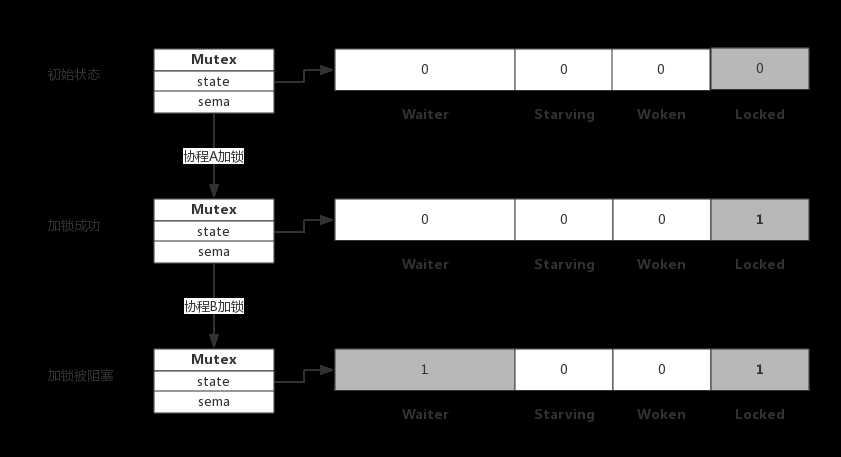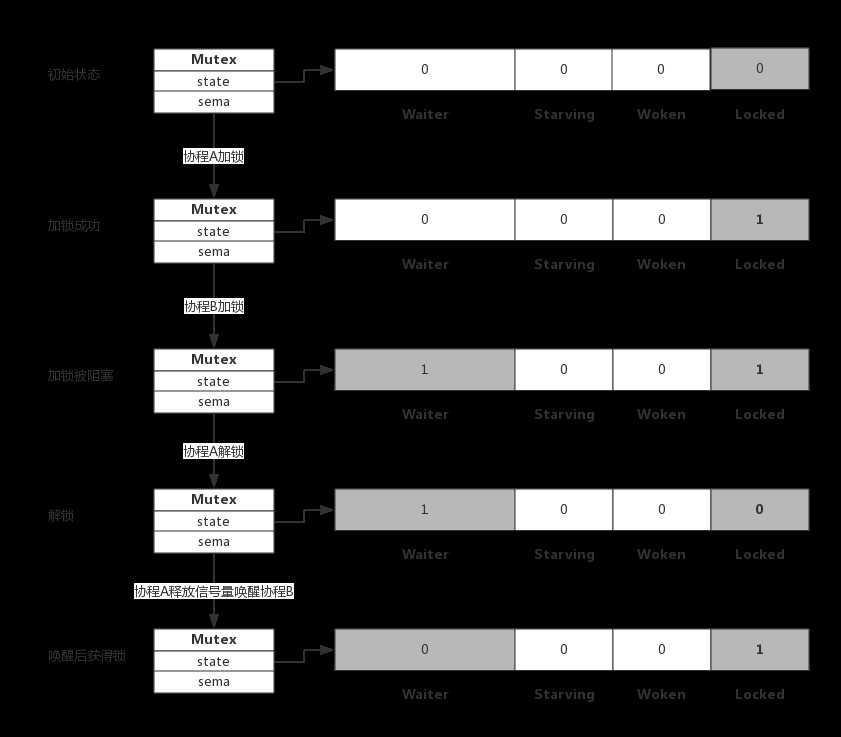标签:pbm 利用 限制 一个 pac err 否则 两种方法 bsd
先来看一段go1.12.5中Mutex的源码:

// Copyright 2009 The Go Authors. All rights reserved.
// Use of this source code is governed by a BSD-style
// license that can be found in the LICENSE file.
// Package sync provides basic synchronization primitives such as mutual
// exclusion locks. Other than the Once and WaitGroup types, most are intended
// for use by low-level library routines. Higher-level synchronization is
// better done via channels and communication.
//
// Values containing the types defined in this package should not be copied.
package sync
import (
"internal/race"
"sync/atomic"
"unsafe"
)
func throw(string) // provided by runtime
// A Mutex is a mutual exclusion lock.
// The zero value for a Mutex is an unlocked mutex.
//
// A Mutex must not be copied after first use.
type Mutex struct {
state int32
sema uint32
}
// A Locker represents an object that can be locked and unlocked.
type Locker interface {
Lock()
Unlock()
}
const (
mutexLocked = 1 << iota // mutex is locked
mutexWoken
mutexStarving
mutexWaiterShift = iota
// Mutex fairness.
//
// Mutex can be in 2 modes of operations: normal and starvation.
// In normal mode waiters are queued in FIFO order, but a woken up waiter
// does not own the mutex and competes with new arriving goroutines over
// the ownership. New arriving goroutines have an advantage -- they are
// already running on CPU and there can be lots of them, so a woken up
// waiter has good chances of losing. In such case it is queued at front
// of the wait queue. If a waiter fails to acquire the mutex for more than 1ms,
// it switches mutex to the starvation mode.
//
// In starvation mode ownership of the mutex is directly handed off from
// the unlocking goroutine to the waiter at the front of the queue.
// New arriving goroutines don‘t try to acquire the mutex even if it appears
// to be unlocked, and don‘t try to spin. Instead they queue themselves at
// the tail of the wait queue.
//
// If a waiter receives ownership of the mutex and sees that either
// (1) it is the last waiter in the queue, or (2) it waited for less than 1 ms,
// it switches mutex back to normal operation mode.
//
// Normal mode has considerably better performance as a goroutine can acquire
// a mutex several times in a row even if there are blocked waiters.
// Starvation mode is important to prevent pathological cases of tail latency.
starvationThresholdNs = 1e6
)
// Lock locks m.
// If the lock is already in use, the calling goroutine
// blocks until the mutex is available.
func (m *Mutex) Lock() {
// Fast path: grab unlocked mutex.
if atomic.CompareAndSwapInt32(&m.state, 0, mutexLocked) {
if race.Enabled {
race.Acquire(unsafe.Pointer(m))
}
return
}
var waitStartTime int64
starving := false
awoke := false
iter := 0
old := m.state
for {
// Don‘t spin in starvation mode, ownership is handed off to waiters
// so we won‘t be able to acquire the mutex anyway.
if old&(mutexLocked|mutexStarving) == mutexLocked && runtime_canSpin(iter) {
// Active spinning makes sense.
// Try to set mutexWoken flag to inform Unlock
// to not wake other blocked goroutines.
if !awoke && old&mutexWoken == 0 && old>>mutexWaiterShift != 0 &&
atomic.CompareAndSwapInt32(&m.state, old, old|mutexWoken) {
awoke = true
}
runtime_doSpin()
iter++
old = m.state
continue
}
new := old
// Don‘t try to acquire starving mutex, new arriving goroutines must queue.
if old&mutexStarving == 0 {
new |= mutexLocked
}
if old&(mutexLocked|mutexStarving) != 0 {
new += 1 << mutexWaiterShift
}
// The current goroutine switches mutex to starvation mode.
// But if the mutex is currently unlocked, don‘t do the switch.
// Unlock expects that starving mutex has waiters, which will not
// be true in this case.
if starving && old&mutexLocked != 0 {
new |= mutexStarving
}
if awoke {
// The goroutine has been woken from sleep,
// so we need to reset the flag in either case.
if new&mutexWoken == 0 {
throw("sync: inconsistent mutex state")
}
new &^= mutexWoken
}
if atomic.CompareAndSwapInt32(&m.state, old, new) {
if old&(mutexLocked|mutexStarving) == 0 {
break // locked the mutex with CAS
}
// If we were already waiting before, queue at the front of the queue.
queueLifo := waitStartTime != 0
if waitStartTime == 0 {
waitStartTime = runtime_nanotime()
}
runtime_SemacquireMutex(&m.sema, queueLifo)
starving = starving || runtime_nanotime()-waitStartTime > starvationThresholdNs
old = m.state
if old&mutexStarving != 0 {
// If this goroutine was woken and mutex is in starvation mode,
// ownership was handed off to us but mutex is in somewhat
// inconsistent state: mutexLocked is not set and we are still
// accounted as waiter. Fix that.
if old&(mutexLocked|mutexWoken) != 0 || old>>mutexWaiterShift == 0 {
throw("sync: inconsistent mutex state")
}
delta := int32(mutexLocked - 1<<mutexWaiterShift)
if !starving || old>>mutexWaiterShift == 1 {
// Exit starvation mode.
// Critical to do it here and consider wait time.
// Starvation mode is so inefficient, that two goroutines
// can go lock-step infinitely once they switch mutex
// to starvation mode.
delta -= mutexStarving
}
atomic.AddInt32(&m.state, delta)
break
}
awoke = true
iter = 0
} else {
old = m.state
}
}
if race.Enabled {
race.Acquire(unsafe.Pointer(m))
}
}
// Unlock unlocks m.
// It is a run-time error if m is not locked on entry to Unlock.
//
// A locked Mutex is not associated with a particular goroutine.
// It is allowed for one goroutine to lock a Mutex and then
// arrange for another goroutine to unlock it.
func (m *Mutex) Unlock() {
if race.Enabled {
_ = m.state
race.Release(unsafe.Pointer(m))
}
// Fast path: drop lock bit.
new := atomic.AddInt32(&m.state, -mutexLocked)
if (new+mutexLocked)&mutexLocked == 0 {
throw("sync: unlock of unlocked mutex")
}
if new&mutexStarving == 0 {
old := new
for {
// If there are no waiters or a goroutine has already
// been woken or grabbed the lock, no need to wake anyone.
// In starvation mode ownership is directly handed off from unlocking
// goroutine to the next waiter. We are not part of this chain,
// since we did not observe mutexStarving when we unlocked the mutex above.
// So get off the way.
if old>>mutexWaiterShift == 0 || old&(mutexLocked|mutexWoken|mutexStarving) != 0 {
return
}
// Grab the right to wake someone.
new = (old - 1<<mutexWaiterShift) | mutexWoken
if atomic.CompareAndSwapInt32(&m.state, old, new) {
runtime_Semrelease(&m.sema, false)
return
}
old = m.state
}
} else {
// Starving mode: handoff mutex ownership to the next waiter.
// Note: mutexLocked is not set, the waiter will set it after wakeup.
// But mutex is still considered locked if mutexStarving is set,
// so new coming goroutines won‘t acquire it.
runtime_Semrelease(&m.sema, true)
}
}
type Mutex struct {
state int32 //互斥锁的状态
sema uint32 //信号量,协程阻塞等待该信号量,解锁的协程释放信号量从而唤醒等待信号量的协程。
}

查资料的时候找到一张很好的展示Mutex的内存布局的图:
协程之间抢锁实际上是抢给Locked赋值的权利,能给Locked域置1,就说明抢锁成功。抢不到就阻塞等待Mutex.sema信号量,一旦持有锁的协程解锁,等待的协程会依次被唤醒。
(这个作者写的真好,原文链接我放到文末了~)
(有时候很恍惚,自己到底有没有写博客的必要,大部分时候都是互联网的搬运工,总有一天,我也能写出纯原创的技术博客~)
go的互斥有两种操作模式:正常模式和饥饿模式
在正常模式下,等待状态的协程(等待者)按照FIFO顺序排队。一个由沉睡(sleep)醒转(就绪)来的协程不拥有互斥锁,并且它对于互斥锁的竞争并不如新到来的协程有优势。新到来的协程可能已经在CPU上运行,并且可能数量还很多。但是,如果醒转来的等待者在队列中阻塞等待互斥锁超过1毫秒,正常模式将会切换到饥饿模式。
在饥饿模式下,互斥锁的所有权直接从释放锁的协程传递到队列最前的等待者。新到来的协程即使有竞争优势,也不会去争取互斥锁,相反,它们会到队列尾部排队等候。
如果醒转来的等待者获得互斥锁的所有权并且发现(1)它是队列中的最后一个等待者,或者(2)它等待不到1ms,它便会把饥饿模式切换到正常模式。
正常模式具有相当好的性能,因为即使存在阻塞的等待者,协程也可以连续多次获取互斥锁。
而饥饿模式可以预防到达协程迟迟得不到处理(反而可能被远远排在新协程之后),说白了,饥饿模式就是为防止协程进入饥饿状态忙等而设。
Mutex只提供了两种方法,即Lock()加锁和Unlock()解锁。
以上面那张Mutex内存布局图为例,最简单毫无阻塞的加锁就是将Locked置为1,当锁已被占用,则将Waiter++,协程进入阻塞,直到Locked值变为0后被唤醒。

仍是以上面那张Mutex内存布局图为例,没有其他协程阻塞等待加锁(即Waiter为0),则只要将Locked置为0,不需要释放信号量。若解锁时,有1个或多个协程阻塞(即Waiter>0),则需要在将Locked置为0后,释放信号量唤醒阻塞的协程。

上面我们说到,加锁时可能被阻塞,此时,协程并不是立即进入阻塞,而是会持续检测Locked是否变为0,这个过程即为自旋(spin)过程。从源码mutex源码中runtime_canSpin()和runtime_doSpin()两个方法,它们就是用来判断是否可以自旋(即是否符合自旋条件)和执行自旋的。
自旋必须满足一下所有条件:
限制自旋次数很好理解,关于CPU核数,一开始我不理解为什么要限制这个,不妨来设想一下协程自旋的场景,假设一个协程主动释放了锁并释放了信号量,我们的协程在对处理器的竞争中惨败,因此进入短暂自旋,以期寻找其他门路,即看看其他处理器是不是正有协程准备解锁,试想,假如只有1核,刚刚在和我们的竞争中获取取得锁控制权的协程,怎么可能在短期内释放锁,因此只能直接进入阻塞。
至于什么是GOMAXPROCS呢?就是逻辑CPU数量,它可以被设置为如下几种数值:
一般情况下,可以使用runtime.NumCPU查询CPU数量,并使用runtime.GOMAXPROCS()进行设置,如:runtime.GOMAXPROCS(runtime.NumCPU),将逻辑CPU数量设置为物理CPU数量。
现在想想,对Process进行限制,是不是显而易见的事。
至于可运行队列为什么必须为空,我的理解,就是当前只能有这一条就绪线程,也就是说同时只能有一条自旋。
可以更充分的利用CPU。
如果协程通过自旋获得锁,那么之前被阻塞的协程将无法获得锁,如果加锁的协程特别多,每次都通过自旋获得锁,那么之前被阻塞的协程将很难获得锁,从而进入饥饿状态。因此,在1.8版本以后,饥饿状态(即Starving为1)下不允许自旋。
自旋和模式切换是有区别的,自旋发生在阻塞之前,模式切换发生在阻塞之后。
整个互斥过程是围绕着Mutex量进行的,即争夺对Mutex内存的修改权,Mutex可以看作是处理器的钥匙,争夺到Mutex的协程可以被处理。
Woken的作用:
Woken用于加锁和解锁过程的通信,譬如,同一时刻,有两个协程,一个在加锁,一个在解锁,在加锁的协程可能在自旋,此时把Woken置为1,通知解锁协程不必释放信号量了。也就是说Woken标志着当前有就绪状态的进程,不用解锁协程去通知。
https://my.oschina.net/renhc/blog/2876211
另外还有一篇详解mutex源码的博客:
https://blog.csdn.net/qq_31967569/article/details/80987352
标签:pbm 利用 限制 一个 pac err 否则 两种方法 bsd
原文地址:https://www.cnblogs.com/StrayLesley/p/10943889.html